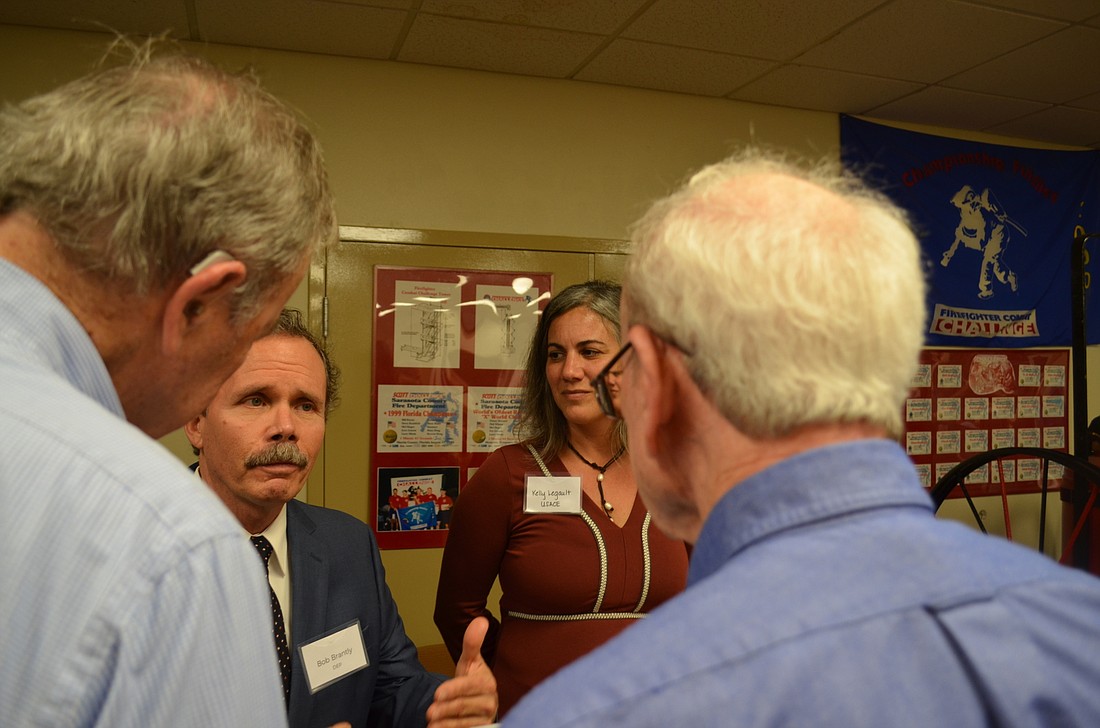- November 19, 2025
-
-
Loading

Loading

Bob Brantly stood in the back of a crowded room at the Waldemere Fire Station for 90 minutes Nov. 30 and offered a vigorous defense of the Army Corps of Engineers’ proposal to dredge Big Pass and renourish Lido Key.
If Siesta Key residents were hoping the state would block the project, Brantly’s comments were deflating — because he works as an engineer for the Florida Department of Environmental Protection.
FDEP is still reviewing the application to dredge Big Pass, which is also supported by the city of Sarasota. The state agency has a Dec. 27 deadline for announcing whether it intends to issue a permit for the project, and held a workshop last week to gather public input in advance of a decision.
The project seeks to take 1.2 million cubic yards of sand from Big Pass, which has never been dredged, to renourish critically eroded portions of the Lido shoreline. Siesta residents, worried about the project’s impact on their shoreline to the south of Big Pass, continued to argue the Army Corps’ proposal was flawed.
To their dismay, Brantly was quick to reject the criticisms.
“In my opinion, the concerns the residents on Siesta Key have raised have been answered by the work reported in the package the Army Corps submitted,” Brantly said.
Brantly assured residents a project wouldn’t go forward without a mandate to monitor the impacts. If Siesta Key showed adverse effects following the dredge, the Army Corps would be prohibited from taking more sand before addressing that issue.
He also endorsed the Army Corps’ modeling, which has been the subject of criticism from opponents. Peter van Roekens, chairman of Save our Siesta Sand 2, cited a 2008 Sarasota County-ordered study that notes sediment transport modeling cannot be done “without a considerable margin of error.”
Brantly acknowledged there could be errors in the Corps model that shows no impact on Siesta Key. He said that’s because the coastal system can vary greatly from year to year — even without any human impact. Still, he said the models provided assurance that Big Pass wouldn’t be radically impacted by the project.
“What it did show is there wasn’t going to be any sudden and significant deflation of the ebb shoal,” Brantly said.
But what if, one resident asked, the effects of the project were so severe that Siesta Key Beach was significantly damaged after the initial dredging effort?
Brantly said that’s a scenario that’s so unlikely that it’s not worth considering, given the robust state of the Siesta shoreline.
Siesta stakeholders now seem to see the intent to issue announcement as inevitable — though that doesn’t mean they’re giving up the fight. Immediately following the meeting, van Roekens said Save our Siesta Sand 2 would contest the issuance of any permit for the project.
“Once Pandora’s Box has been opened, there is no going back.” — Peter van Roekens
“If the intent to permit is issued in its present form, consider this our notice of intent to challenge,” van Roekens wrote. “Once Pandora’s Box has been opened, there is no going back.”
Catherine Luckner, a Siesta Key Association board member, shared a similar perspective. At a Dec. 1 SKA meeting, she assured the audience that the residents association would contest the proposed dredging at every stage of the process, which will include the Corps’ effort to obtain federal funding.
Luckner believed Siesta residents offered compelling reasons to block the Big Pass dredge, but she was also resigned to the fact that state approval appeared imminent.
“I wish it weren’t true, but I believe they have essentially decided to do that,” she said.
Lido Key leaders, meanwhile, are forced to play a waiting game as Siesta residents mount a challenge. Carl Shoffstall, president of the Lido Key Residents Association, said Lido and St. Armands residents were discussing legal options against Siesta Key factions attempting to block the renourishment effort.
“Lido needs this sand.” — Carl Shoffstall
Hugh Fiore, president of the St. Armands Residents Association, said members of that group were just as anxious as Lido residents to see the beach renourished.
“Lido Beach is consistently the No. 1 reason people purchase homes on St. Armands,” Fiore said.
While Siesta residents are offering an array of potential problems with the proposed project, Lido residents are making a more straightforward argument in favor of the dredging.
“Lido needs this sand,” Shoffstall said. “We’re at the end.”
Stephen Leatherman — better known as Dr. Beach — is cautioning against moving ahead with plans to dredge Big Pass, although he admits he hasn’t studied the Army Corps of Engineers proposal for renourishing Lido Key.
Leatherman, who serves as director of the Laboratory for Coastal Research at Florida International University, produces an annual ranking of the top beaches in America. Siesta Key Beach finished No. 1 on his ranking in 2011, and No. 2 in 2016.
As a result, Leatherman said, he’s protective of the Siesta shoreline. He encouraged the Army Corps to conduct a more detailed Environmental Impact Statement to get a clearer picture of the potential impact of the dredge.
“I think we really need to study this very carefully and leave no stone unturned,” Leatherman said. “If it takes a little more time, so be it.”
The county has already requested an Environmental Impact Statement — a request the Army Corps of Engineers formally rejected last week. Although the Army Corps remains confident the project will have no impact on Siesta Key, Leatherman still recommended a cautious approach.
If the Army Corps produced an EIS that showed no impact on Siesta Key, Leatherman said he’d still be hesitant to move forward with the planned dredging. Instead, he suggested the Army Corps could take a smaller amount of sand from Big Pass to study the impacts of the dredge.
“We have to do no harm,” Leatherman said. “That’s the first rule, isn’t it?”